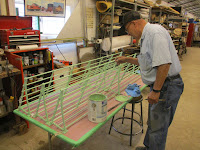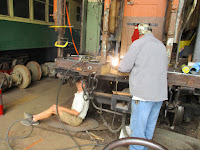Today was another exciting, fun-filled, and productive Wednesday at IRM. I'll start with the 453. Last time the trolley bases were attached to the roof, and today I finished inserting parts to hold the springs, and then the poles were installed. Tim helped briefly to lock the bases down, but the rest of it I was able to do myself. As usual, the lighting doesn't lend itself to picture taking very well.
But you can clearly see that the poles are now in place, bolted tight, and connected.
And they're even the right length!
So the roof is rapidly approaching completion. I dug out the lighting arrestor. I'm not sure we actually want to connect it, but it needs to be in place. It was stripped and painted.
And then bolted onto the roof boards.
Then I got the two retrievers that came with the car and brought them into the shop. They're on the bench where the trolley base parts were. The retriever experts need to check them out.
Meanwhile, lots of other things were happening. Here Pete Galayda is touching up the baggage racks for the 160.
And he had help from Lorne and a new member, Fritz.
They're doing a great job of stripping and refinishing the woodwork in the main compartment where the baggage racks are attached.
It really looks great.
Gerry was doing welding on the end of the 2872, helping out Tim.
Victor and Bill came over to soak their piece of canvas, the last one for the Pennsy bobber. It's only 12' square, so much easier to handle than the 60' long pieces we need for interurban cars.
And on the way out, I stopped by Barns 10 and 11 to check out the work there. We should be getting more pictures of their progress soon, but I got a couple of pictures of the dynamometer being sandblasted.
This is probably what we will want done on the 453.
And while I was there, I stopped in to see my old friend Jack Biesterfeld. The Green Bay car is now at the west end of track 104, and Jack continues to work on the windows and interior trim.
Nice!
Finally, I went over to see the 321 for the first time since it got moved to track 114. It's still as wretched as ever, but now it's right behind the Dodge inspection car. At least they're under cover.
And in conclusion, don't forget Thomas this weekend!






















6 comments:
Do most of your cars have presumed working lightening arrestors? I suppose they are basically a gas discharge tube that hopefully arcs over when the big one hits?
C Kronenwetter
No, actually this type is a phenolic capacitor. Other than meggering it to be sure it isn't going to spontaneously cause a flashover, I don't know how we would test it.
For our operation, however, the main defense against lightning is to put the cars away before the lightning gets here. You generally don't have thunderstorms sneak up on you without warning. And if a car were caught outside, it's standard practice to stop and lower the poles until the storm has passed. A car at East Troy was badly damaged when it was struck by lightning with the pole still up.
Yes, as was most of the electronic stuff at the depot. The radio antenna on the roof of the depot got pretty well fried when it was struck.
C Kronenwetter
I highly recommend that you do NOT install this style of arrestor, they contain PCB's. Even if you mount it and don't connect it if it develops a leak then you will really have a mess on your hands.
How many uF are these things typically rated at?
C Kronenwetter
I remember now that this subject came up about a year ago when I was working on the 451, and I don't think we came to any definite conclusion. Almost all of our cars have lightning arrestors of this type, I believe, and we haven't had any problems that I know of. I don't know why they would develop a leak.
As for the rated capacitance, I don't know. When you connect a megger to an arrestor, you can watch it charge up the capacitor. The indicated resistance starts out near zero, and climbs up towards infinity in a matter of five or ten seconds. If I had some known resistors on hand, we could easily measure the discharge rate and calculate the actual capacitance, of course.
Post a Comment